
Gertrude Vanderbilt Whitney was an American sculptress, art patron and collector, and founder in 1931 of the Whitney Museum of American Art in New York City. She was a prominent social figure and hostess, who was born into the wealthy Vanderbilt family and married into the Whitney family.
The Three Graces may refer to:
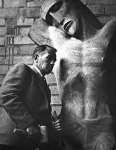
Albert Stewart was an American sculptor.

Robert Laurent was a French-American modernist figurative sculptor, printmaker and teacher. His work, the New York Times wrote,"figured in the development of an American sculptural art that balanced nature and abstraction." Widely exhibited, he took part in the Whitney's 1946 exhibition Pioneers of Modern Art. Credited as the first American sculptor to adopt a "direct carving" sculpting style that was bolder and more abstract than the then traditional fine arts practice, which relied on models, Laurent's approach was inspired by the African carving and European avant-garde art he admired, while also echoing folk styles found both in the U.S. and among medieval stone cutters of his native Brittany. Best known for his virtuoso mastery of the figure, Laurent sculpted in multiple media, including wood, alabaster, bronze, marble and aluminum. His expertise earned him major commissions for public sculpture, most famously for the Goose Girl for New York City's Radio City Music Hall, as well as for Spanning the Continent for Philadelphia's Fairmount Park. After the Depression, he was also the recipient of several Works Progress Administration (WPA) Federal Art Project commissions under the New Deal, including a bas-relief called Shipping for the exterior of Washington, D.C.'s Federal Trade Commission Building, commissioned by the Treasury Department’s Section of Fine Arts in 1938.
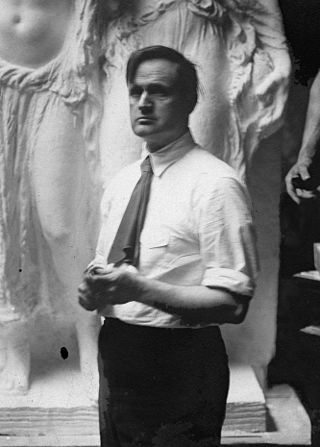
James Earle Fraser was an American sculptor during the first half of the 20th century. His work is integral to many of Washington, D.C.'s most iconic structures.

Isidore Konti was a Vienna-born sculptor. He began formal art studies at the age of 16 when he entered the Imperial Academy in Vienna, where he studied under Edmund von Hellmer. In 1886, he won a scholarship that allowed him to study in Rome for two years. While there he developed a love of Renaissance art that was to affect the nature of his mature sculpture. Upon returning to Austria, Konti worked as an architectural modeler.

Robert Ingersoll Aitken was an American sculptor. Perhaps his most famous work is the West Pediment of the United States Supreme Court Building.

The TitanicMemorial is a granite statue in southwest Washington, D.C., that honors the men who gave their lives so that women and children might be saved during the RMS Titanic disaster. The thirteen-foot-tall figure is of a partly clad male figure with arms outstretched standing on a square base. The base is flanked by a square exedra, created by Henry Bacon, that encloses a small raised platform. The statue was erected by the Women's Titanic Memorial Association.
Oronzio Maldarelli was an American sculptor and painter (1892–1963) born in Naples, Italy.
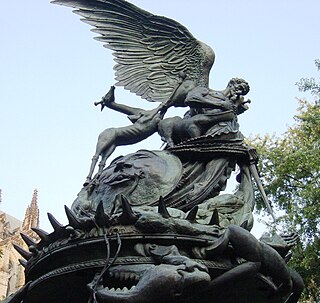
Greg Wyatt is an American representational sculptor who works primarily in cast bronze, and is the sculptor-in-residence at the Cathedral Church of St. John the Divine in New York City.

Brenda Putnam was an American sculptor, teacher and author.

The Dupont Circle Fountain, formally known as the Rear Admiral Samuel Francis Dupont Memorial Fountain, is a fountain located in the center of Dupont Circle in Washington, D.C. It honors Rear Admiral Samuel Francis Du Pont, a prominent American naval officer and member of the Du Pont family. The fountain replaced a statue of Du Pont that was installed in 1884. Designed by Henry Bacon and sculpted by Daniel Chester French, the fountain was dedicated in 1921. Prominent guests at the dedication ceremony included First Lady Florence Harding, Secretary of War John W. Weeks and Secretary of the Navy Edwin Denby.

The Darlington Memorial Fountain is a gilded bronze statue by C. Paul Jennewein. It is located at Judiciary Park at 5th Street and D Street, Northwest, Washington, D.C., in the Judiciary Square neighborhood.

Vincent Glinsky was an American sculptor. He is especially noted for his architectural decorations.

The Quest, sometimes referred to as Saturday Night at the Y or Three Groins in a Fountain, is an outdoor marble sculpture and fountain designed by Count Alexander von Svoboda, located in Portland, Oregon in the United States. The sculpture, carved in Italy from a single 200-ton block of white Pentelic marble quarried in Greece, was commissioned by Georgia-Pacific in 1967 and installed in front of the Standard Insurance Center in 1970. It depicts five nude figures, including three females, one male and one child. According to the artist, the subjects represent man's eternal search for brotherhood and enlightenment.

The Founders of the Daughters of the American Revolution is a sculpture located beside Constitution Hall in Washington, D.C., United States. Dedicated in 1929, the sculpture was created by artist and socialite Gertrude Vanderbilt Whitney in honor of the four founders of the Daughters of the American Revolution (DAR): Mary Desha, Mary Smith Lockwood, Ellen Hardin Walworth, and Eugenia Washington. The sculpture is one of three outdoor artworks in Washington, D.C. by Whitney, the other two being the Titanic Memorial and the Aztec Fountain at the Pan American Union Building.
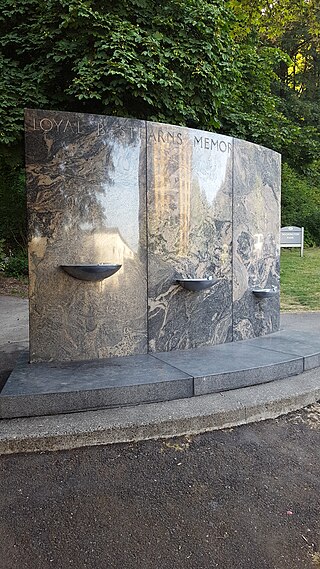
The Loyal B. Stearns Memorial Fountain, also known as the Judge Loyal B. Stearns Memorial Fountain, is an outdoor 1941 drinking fountain and sculpture by the design firm A. E. Doyle and Associates, located in Portland, Oregon. It was erected in Washington Park in honor of the former Oregon judge Loyal B. Stearns.

Benjamin Franklin – also known as the Benjamin Franklin Memorial, Benjamin Franklin Statue and Cogswell Historical Monument – is an outdoor sculpture in Washington Square, San Francisco, California.

The Washington Heights-Inwood War Memorial, also known as the Inwood Monument, is a World War I (WWI) memorial monument sculpted by Gertrude Vanderbilt Whitney, with a base by Albert Randolph Ross. It is located at the intersection of Broadway and Saint Nicholas Avenue between 167th and 168th Streets in Mitchel Square Park, New York City, New York.
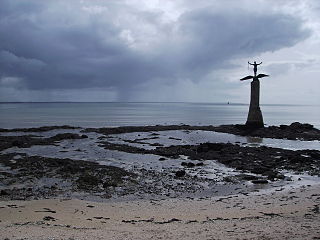
The American Expeditionary Forces Memorial is a monument to the landing of the American Expeditionary Forces in France in 1917, during the First World War. It features a large bronze sculpture designed by Gertrude Vanderbilt Whitney. It was erected in Saint-Nazaire in 1926, destroyed in 1941 during the German occupation of France in the Second World War, and recreated and reinstalled in 1989.



















